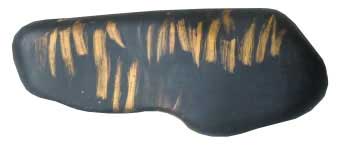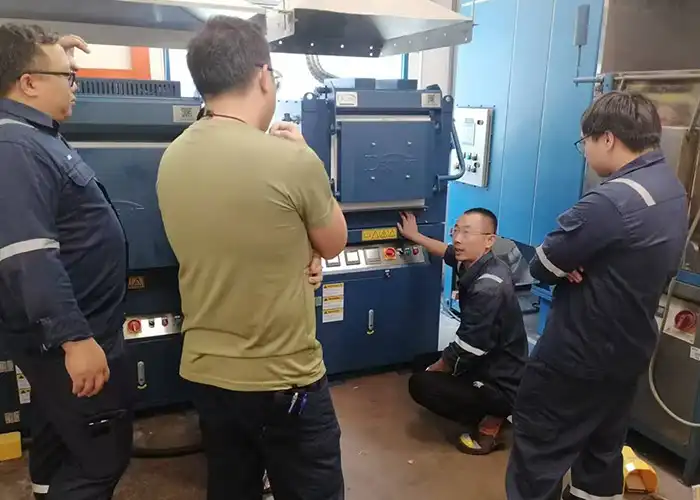Touchstones identify the authenticity and purity of gold
-Article source Baidu Baike
Touchstone is a solid black stone with a streak of gold on it to show the purity of the gold. The mineralogical name is Bi Xuanite, also known as flint slate, siliceous slate, etc. It is a basaltic extrusive rock, dense, hard, and black. As an ornamental stone, it is best to have a dark body, and if there is a gold thread like a hairspring on it, it is a top grade. The touchstones have different shapes, some are round like eggs, some are covered with corrugated pits and undulations, and some have traces like human fingernails, which become “nail marks”.
Figure 1: The picture of the stone axe of the Qi family culture is the stone axe of the Qi family culture from Gansu.

Mineral Composition
A touchstone is a kind of stone that can be used to identify gold, and its mineralogical name is Bishenite. Most of the stones used as touchstones are dense and hard black siliceous rocks, such as siliceous slate and chert. Flint rock is composed of protein, chalcedony and microcrystalline quartz. It is dense and hard, and the shell fracture is charcoal or black. It is often produced in layers, strips, convex mirrors or nodules. The flint strips or nodules are often produced in in carbonate rock formations. The dark siliceous pebbles near the Guzong Jintong site in Xinjiang, the aeolian dark siliceous rocks with prismatic rocks commonly known as “desert paint” on the Gobi Desert, and the black Yuhua stones in Nanjing, etc., can be processed into very good after grinding. the touchstone.
Test Gold
In ancient times, the authenticity and purity of gold were identified by scratching on the touchstone. The method of using touchstones to identify the purity of gold, among the traditional gold identification methods, is more rigorous and reliable than the simple methods of weighing, listening to the sound, characterizing the nails, and looking at the fracture because there are a series of gold medals that can be compared. Therefore, even in modern times, it is still one of the main identification methods for professional appraisers in some banks and gold shops. However, driven by the development of science and technology, compared with the accurate methods such as electron probe method and X-ray fluorescence method, the touchstone method, which relies heavily on the eyesight of the discriminator, has shown disadvantages in terms of accuracy and began to gradually withdraw from this stage.
The color of the gold powder left by gold scratched on the touchstone is called streak in mineralogy, and it is also a commonly used method in modern mineralogy to distinguish minerals by the color of the mineral end (stripe). Gold is soft and easily scratches. The darker the color of the touchstone, the smoother and flatter it will be, and the clearer the streaks will be. It is usually made of black flint or siliceous slate with a hardness of about 6.5 and a fine texture. The principle of using touchstones to identify the fineness of gold is to judge according to the reflectivity and color of the streaks. Therefore, there is a formula of “looking at the color flat and looking at the light obliquely”, which is a colorimetric method. Streak the gold sample on the touchstone, and then draw streaks on the same touchstone for a series of standard color pairs of gold medals. Depending on the comparison, until the streak of the gold medal is consistent with the streak of the sample, the color of the gold medal is the color of the sample. This colorimetric operation must be carried out by a master with rich practical experience, and due to the different colors of clear gold, small mixed gold, and large mixed gold, it is necessary to select clear gold, small mixed gold, and large mixed gold respectively. to gold. After choosing the correct pair of gold medals, you need to compare them one by one from a total of more than 20 gold medals from 12 to 24K. The high requirements for the professional quality of operators and the limited series and number of gold medals are the shortcomings of this method. After all, the composition of gold jewelry is becoming more and more complex with the advancement of science and technology. To deal with high-precision, highly confusing identification problems.
Touch Method
1. Clean the touchstone
It is best to use clean water when grinding, rinse with clean water after grinding, and keep the stone surface clean before and after applying oil. To hold the stone, take both ends, do not touch the stone surface with your fingers, and be careful not to be contaminated with dust and moisture (especially sweat in your mouth and hands), otherwise it will not be easy to color. The oil used should also be clean, the castor bean shell should be removed, the hemp seed kernels should be wrapped with silk cloth and crushed, so that the oil can be leached from the crevices of the cloth. When the oil bag is not in use, it should be placed in a bottle or box with a lid to prevent it from being contaminated with dust.
2. Apply oil evenly
When applying oil, apply force evenly. The stone surface should be used in two halves. The oil channel should be as long as the two ends of the touchstone, and the width should be 2 cm. The edge of the oil channel should be straight and even, and should be parallel to the edge of the touchstone. It forms a clear demarcation with the other half that is not anointed with oil, so that the length of the golden road can be the same.
3. Oil surface is level
After applying the oil, use a clean silk cloth to wipe off the oil slick, so that the oil on it is a thin layer, but it should not be wiped too dry, it will not be easy to color, too thick and easy to roll oil and turn black. If you scratch gold on the touchstone, it will be colored and marked. “Look at the color flat, look at the light obliquely, and listen carefully to the sound.” Gold contains a lot of silver, which is soft, and it is blue on the touchstone; gold contains a lot of copper, and it is hard, and a stroke on the touchstone makes a sound. If there is a standard gold medal, compared with the trace, it is immediately clear.
When using a touchstone to grind the Dao, generally hold the stone in the left hand and the gold in the right hand, hold the stone with the thumb on top and the remaining fingers on the bottom, with half of the oil applied on the top, hold the stone horizontally in the hand and hold it firmly on the table without moving it. When grinding the Dao, the real object or the pair of cards should be firmly against the stone surface, and the right hand holding the gold should use the wrist strength. The way to grind is generally 2 cm long and 0.5 cm wide. The number of times of grinding is about 20 times for large pieces (strips, ingots), and more than ten times for small pieces. When grinding, gradually spread from one end in order to avoid repeated coating and grinding. The physical road and the opposite card road should be the same length and width, so as to compare the color and luster.




